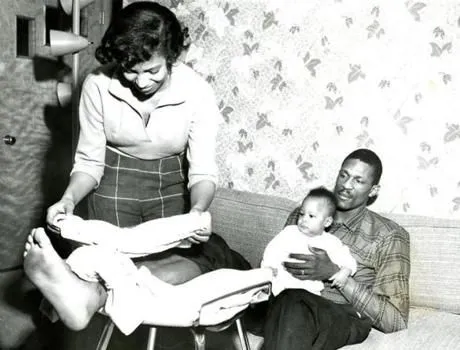Rose Swisher etched her name in history as a groundbreaking African-American supermodel and passionate activist who redefined notions of beauty, advocated for civil rights, and lived life on her own terms. Though much of her journey unfolded away from the spotlight’s glare, her presence sparked lasting change.
Born in 1929 in Chicago, Illinois, Rose gained formative experiences that instilled in her a spirit of resilience. After building the foundations at DuSable High School, she ventured west for higher education at the University of San Francisco. Here, she met Bill Russell, the man she would eventually marry.
Modeling Career
After college, Rose embarked on a modeling career that broke racial barriers. At a time when opportunities proved scarce for African-American models, Rose’s rise represented a triumph. Her photos graced the pages of high-profile publications, including “Ebony” and “Beauty Parade,” ushering in a shift towards inclusivity in the fashion industry.
With her poise, intelligence, and determination, Rose Swisher ascended the runways and featured in major print campaigns. Each opportunity highlighted her versatility and the enduring power of embracing uniqueness. Beyond the commercial realm, her presence sparked cultural shifts by redefining narrow beauty standards.
Marriage to Bill Russell
During her time at the University of San Francisco, Rose’s life became intertwined with that of basketball phenom Bill Russell. Following a courtship, Rose Swisher and Bill Russell married in 1956, uniting two visionary trailblazers breaking new ground in their respective fields.
The marriage yielded three children—Karen Russell, William Jr., and Jacob Russell— before ending in divorce. While the union concluded, Rose and Bill’s bond pointed towards the possibility of partnerships founded on mutual respect and support between equals.
Activism and Social Justice
Rose lived during an era of sweeping transformation. Beyond influencing perceptions of beauty, she participated in social justice efforts, embracing activism’s power to uplift humanity. She joined protests against the Vietnam War and advocated for civil rights.
By adding her voice to these causes, Rose demonstrated the importance of moving beyond individual goals to engage with broader change. She channeled fame for the greater good, shining a light on struggles and opportunities.
Post-Divorce Years
Following her divorce from Bill Russell, Rose Swisher continued her trailblazing journey, though details of her later personal life remain scarce. Her focus turned further inward, with interests spanning introspection, personal growth, and artistic expression.
Rather than basking in past glory, she maintained a quiet dignity and determination as she navigated life’s complexities. This grace reflected the wisdom gleaned from her remarkable rise and married life.
Lasting Impact
Though she passed away in a California nursing home in 1990, Rose Swisher’s influence reverberates as a reminder of the power stemming from shattering norms. Her modeling career opened doors for generations of diverse models. She forged her own path with courage and enacted positive change.
Today, Rose Swisher’s journey elicits reflection on life’s intersections of identity, partnership, family, and legacy. By embracing her multifaceted self, she transformed broader culture. Her biography serves as a study in empowerment’s ripple effects.
Frequently Asked Questions
When and where was Rose Swisher born?
Rose Swisher was born on December 27, 1929, in Chicago, Illinois. She spent her childhood in Chicago.
Where did Rose Swisher attend university?
Rose Swisher attended the University of San Francisco for her higher education. This is also where she met her future husband, Bill Russell.
What modeling accomplishments was Rose Swisher known for?
Rose Swisher was one of the first successful African-American models of the 1950s. She broke racial barriers and appeared in major magazines like Ebony and Beauty Parade.
When did Rose Swisher marry Bill Russell?
Rose Swisher and Bill Russell married in 1956 after meeting and dating at the University of San Francisco. The marriage ended in divorce after yielding three children.
How did Rose Swisher contribute to social justice causes?
During the 1960s, Rose Swisher utilized her public platform and voice to advocate for civil rights and protest against the Vietnam War. She embraced activism.
What is known of Rose Swisher’s later personal life after her divorce?
After divorcing Bill Russell, Rose Swisher focused on personal growth, introspection, and developing new passions. She valued privacy in her later years.
When and where did Rose Swisher pass away?
Rose Swisher passed away in 1990 in a California nursing home. However, her legacy and impact continue to live on and inspire.
What lasting impact did Rose Swisher have on culture?
Rose Swisher pioneered greater inclusivity in fashion, modeling, and perceptions of beauty. She also contributed to advancing civil rights and inspired future generations of activists.
What core lessons does Rose Swisher’s life story teach?
Rose Swisher’s journey highlights the importance of breaking barriers, embracing authenticity, using platforms for good, and leaving a compassionate legacy.
Why is Rose Swisher’s biography worth studying today?
Rose Swisher’s multifaceted accomplishments and advocacy make her an inspiring figure. Her biography serves as a case study in empowerment and positive change.









